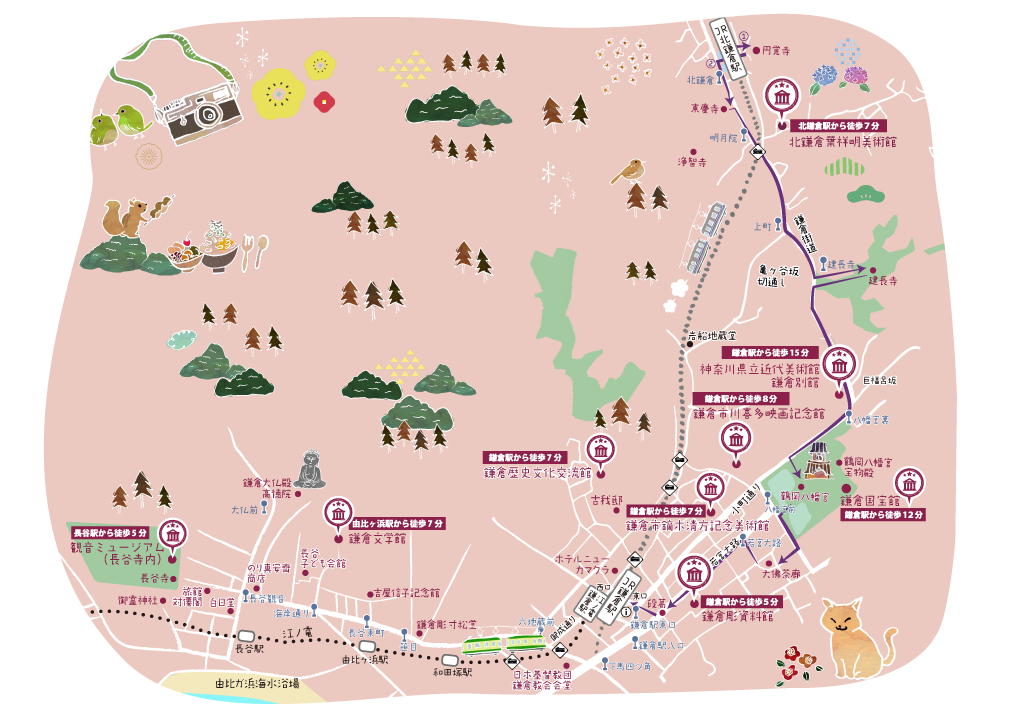
Literary strolls
Literary Course (Kita-Kamakura Station area, Kamakura Station area)

- Kita-Kamakura Station
- 1 minutes-walk
- Kita-Kamakura Station
The stage of the movie of Yasujiro Ozu- 1 minutes-walk
- Engakuji Temple
- 3 minutes-walk
- Tokeiji Temple
- 10 minutes-walk
- Kenchoji Temple
- 9 minutes-walk
- Tsurugaoka Hachiman Shrine
- 3 minutes-walk
- Osaragi Saro
- 6 minutes-walk
- Dankazura
- 4 minutes-walk
- Kamakura Station
Many literary people use it- 1 minutes-walk
- Kamakura Station
 Kita-Kamakura Station Start
Kita-Kamakura Station Start
Kamakura is described in many literary works, from the classics to contemporary literature. This course introduces our literary heritage on a stroll from Kita-Kamakura to the Kamakura Station area.
Kita-Kamakura opened provisionally in 1927 and has been officially operating since 1930. It is known and loved for its a rather charming station building. It was the setting for Ozu Yasujiro’s movie Early Summer. If you go up the stairs to the landing facing the ticket wicket on the Tokyo side, you can see the same old-fashioned sign that appears at the start of the movie. (It says “Kita-Kamakura Station,” but written from left to right.)


Go out the ticket wicket on the tracks for Tokyo and go left on the street there. You will see the White Heron Pond, which is part of the Engakuji temple grounds, but across the tracks from it. Cross the tree-shaded stone bridge for an elegant experience: entering Engakuji.

 1minutes-walk
1minutes-walk
Spot.02
Engakuji Temple
Enter through the temple gate, and you will see huge Japanese cedars on your left and right, soaring into the sky. Thanks to them, the path grows suddenly dark. When he touched the somber air there, Sosuke suddenly sensed the difference between the world outside and the world of the temple. — Natsume Soseki, Mon

Natsume Soseki practiced Zen meditation at Engakuji and described that experience in his novels The Gate and Ten Nights of Dreams. The temple has also been the setting for many literary works, including Shimazaki Toson’s Haru (Spring) and Kawabata Yasunari’s Thousand Cranes. The temple offers early morning Zen meditation sessions every day that anyone can participate in. Why not, like Soseki, try Zen meditation there?
 3minutes-walk
3minutes-walk
Tokeiji temple, known as the divorce temple, was the subject of many senryu, humorous poems, often with the words “Matsugaoka” and “Kamakura.” Today, literary steles dedicated to writers such as Tamura Toshiko stand in the temple precincts and many authors, including Takami Jun, are buried there. The 2015 movie Kakemomi, starring Oizumi Yo, is based on Tokeij hanadayori, a novel by Hasashi Inoue set at Tokeiji.
 10minutes-walk
10minutes-walk
The Kenchoji temple precincts include a stele with a haiku by poet Ishizuka Tomoji and another with a senryu poem by poet Inoue Kenkabo: “One cough, and within that inaudible space, the Imperial Standard.” The temple was the setting for Osaragi Jiro’s novel Kikyo (Homecoming) and Fujisawa Shu’s Bukyoku (Military tune), which was made into a movie starring Ayano Go. The path to the Hansobo, a shrine in the hills deep with the temple precincts, is lined with Kirigaya cherry trees, a variety said to have originated in Kamakura. These unusual cherries have both single and double blossoms that bloom at the same time. Nearby is the Mushizuka (“mound for insects”), which was proposed by neuroscientist Yoro Takeshi and designed by Kengo Kuma, the architect who also designed the New National Stadium.


Kobukurozaka
The road going up the slope in front of Kenchoji passes near an ancient road, the Kobukurozaka Kiritoshi, one of the seven kiritoshi or passes constructed on the steep hills that surround Kamakura. Kobukurozaka is mentioned in the Taiheiki, a military epic. In 1332, the army of Nitta Yoshisada, who supported Emperor Go-Daigo in his conflict with the Kamakura Bakufu, invaded Kamakura via this pass and fought the Bakufu’s forces.

 9minutes-walk
9minutes-walk
Tsurugaoka Hachiman Shrine, which has been located in the center of Kamakura since the Kamakura period (1185-1333), figures in many literary works, from the Tale of the Heike, a military epic from the middle ages, to contemporary works. In early August, the shrine holds its Bonbori Festival, in which about 400 examples of paintings and calligraphy by contemporary writers and other distinguished persons are made into lanterns and line the pathway to the shrine. The lanterns are lit in the evening, dramatically illuminating the paths.
 3minutes-walk
3minutes-walk
(Kamakura City designated Important Structure of Scenic Beauty and Scenic Preservation Building) This tea pavilion, once owned by the novelist Osaragi Jiro, operated as a coffee shop on weekends and holidays. It is also open to the public for one day each spring and fall. It offers a retreat from the busy main street where visitors can enjoy the flowers throughout the seasons and relax.
 6minutes-walk
6minutes-walk
Minamoto Yoritomo built this approach to the Tsurugaoku Hachiman Shrine within the broad Wakamiya Oji avenue as a prayer that his wife, Hojo Masako, would give birth safely. Its construction is described in the Azuma Kagami, the chronicle of the Kamakura Shogunate. Because the Dankazura narrows gradually as it extends from the second torii gate to the Hachiman Shrine, it appears to be longer than it is. When you’ve reached the second torii, be sure to turn around and enjoy the view. In spring, cherry trees will be in bloom on both sides.
 4minutes-walk
4minutes-walk
Kamakura Station has been busy since the opening of the Yokosuka Line in 1889. The station building itself has changed, but this station has been used many writers, including Natsume Soseki, Akutagawa Ryonosuke, Yasano Akiko.
 1minutes-walk
1minutes-walk
Search by themes
Search by areas
- Kita-Kamakura Station area
- Kamakura Station area
- Yuigahama Station area
- Hase Station area
- Gokurakuji Station area














